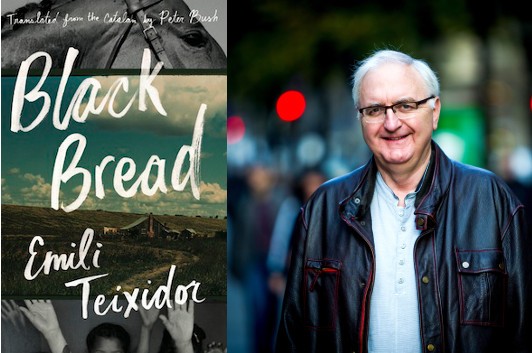Peter Bush’s No-Hope Sucklers

photo: courtesy Peter Bush
Black Bread is one of those novels that builds slowly, through the accrued detail of seemingly disconnected scenes… or, let’s say, a string of scenes where the narrative throughline is not immediately apparent to the reader. It attracted my attention because I know very little about Catalan culture beyond the fact of its existence, and I wanted to learn. And, too, I wanted to hear from its translator, Peter Bush—who wound up explaining how a novel about rural Catalonia stirred up memories of his own English childhood.
My very first memories are of a sow with the litter of piglets she’d just farrowed. Her sty was in our backyard and she was my first pet. On a Saturday morning in September, 1950, my elder sister walked me up to the Odeon to the kids’ session; when I came back, sections of the sow were hanging from our clothesline and the kitchen was full of blood and entrails. Cousin Ray the butcher had paid us a visit. (In post-war, still rationing Britain, it wasn’t unusual for people to keep pigs and chickens in their backyards, but by 1950, that era was coming to an end.)
Our domestic scene was gloomy for other reasons. My mother had arranged for us to move to a new council house with large gardens and light in a leafier part of town, from anonymous Seventh Avenue to a more optimistic Queen’s Road in the run up to a coronation, and my father had opposed this from the start. He didn’t want to leave the house my battling grandmother had forced out of the council when her husband, a village shepherd, fell ill one Christmas and was evicted along with his family from their tied-cottage by the Tory landowner. (As they bickered, I enjoyed the haslets, chitterlings, black puddings and pork-pies Ray had made from my pet.)
Many other memories, family stories and bits of our rural dialect and oral history kept flooding back as I translated Emili Teixidor’s Black Bread. Of course, pork and pig slaughtering have a different history in Catalunya and the whole of the Iberian Peninsula. The autumn pig slaughter is a time for festivities that are part pagan and part the legacy of an Inquisitional anti-Semitic, anti-Muslim tradition. But that’s not on the mind of the adolescents in Black Bread, as they hear about the deaths of those surplus to the litter, the runts, ‘the no-hope piglets, the no-hope sucklers’ who reach the tit too late: “Cry-baby and I shuddered when we heard those curious details, as if nature had also got it wrong with us, who through lack of tit and lack of parents were also destined to be abandoned and forgotten. No-hope children.”
11 September 2016 | in translation |
Amy B. Reid: Conversations Overheard

photo: courtesy Amy Reid
Lately, whenever I can steal a few moments to read uninterrupted, I’ve been diving into Patrice Nganang’s Mount Pleasant, as translated by Amy Baram Reid. It’s a fantastic novel, set in colonial-era Cameroon, but with an early 21st-century frame that allows for an imaginative reinvention of the past, playful without ever losing its darker edges. As Reid notes, there’s a lot going on in this book for one translator to take on, but I’m delighted by how she’s pulled it off so far, and eager to take the rest of the journey with her.
One of the phrases I remember from childhood—and maybe you do to—is “little pitchers have big ears.” It amused me then because of the incongruity of the image (a pitcher with ears?) and also for its truth: kids soak up what they hear, even if the words aren’t meant for them. It also describes the narrative premise of Patrice Nganang’s Mount Pleasant: for if one kid hadn’t been a sponge for all she had overheard, the stories of Mount Pleasant would have been lost forever.
At the heart of Mount Pleasant are the intertwined issues of conversation and translation: conversations in the present between the elderly Sara and the young Bertha, themselves translations of exchanges years before between another Bertha and the same Sara, a young girl who was transformed by stories into a young boy, Nebu. Conversations and stories swirl magically in the court of the Sultan Njoya and, years later, resurface to enchant both the idle youth of Yaoundé and the novel’s readers. Artists discuss aesthetic ideals and lovers their amorous exploits; ambitious plots are revealed and scars disclose traumas born in silence.
Exchanges in the novel take place in multiple languages, and often on the borders between French, English, and German, between Shümum, Shüpamum, and Ewondo. Writing, drawing, and sculpture become the sites where tales and visions are translated—allowed to travel across time and space, as well as language. This concatenation of words and languages made my experience of translating Nganang’s novel exceptionally challenging and rewarding.
8 June 2016 | in translation |

 Our Endless and Proper Work is my new book with Belt Publishing about starting (and sticking to) a productive writing practice.
Our Endless and Proper Work is my new book with Belt Publishing about starting (and sticking to) a productive writing practice. 
